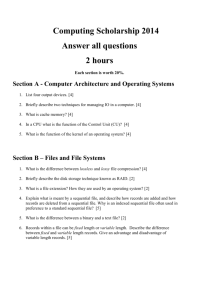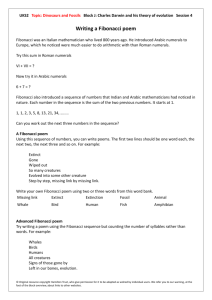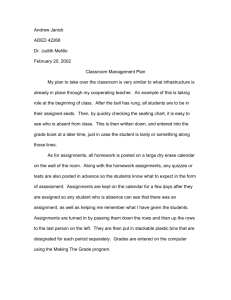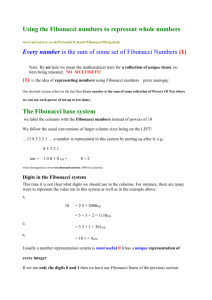The Man of Numbers: Fibonacci`s Arithmetic Revolution
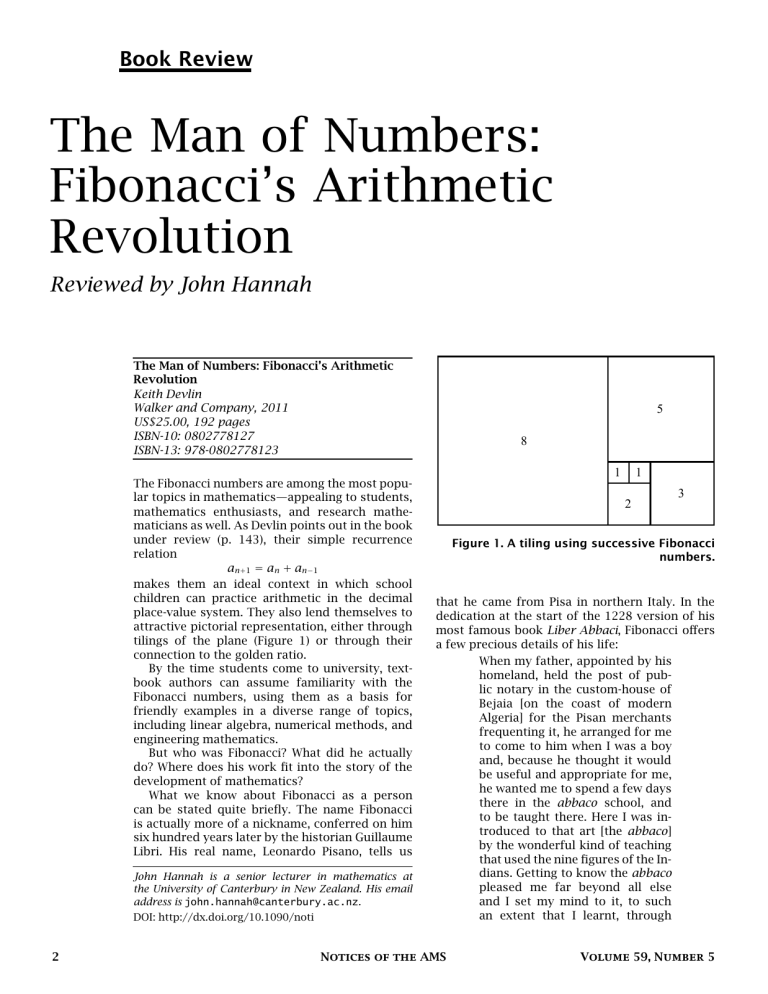
2
Book Review
The Man of Numbers:
Fibonacci’s Arithmetic
Revolution
Reviewed by John Hannah
The Man of Numbers: Fibonacci’s Arithmetic
Revolution
Keith Devlin
Walker and Company, 2011
US$25.00, 192 pages
ISBN-10: 0802778127
ISBN-13: 978-0802778123
The Fibonacci numbers are among the most popular topics in mathematics—appealing to students, mathematics enthusiasts, and research mathematicians as well. As Devlin points out in the book under review (p. 143), their simple recurrence relation a n +
1 = a n
+ a n −
1 makes them an ideal context in which school children can practice arithmetic in the decimal place-value system. They also lend themselves to attractive pictorial representation, either through tilings of the plane (Figure 1) or through their connection to the golden ratio.
By the time students come to university, textbook authors can assume familiarity with the
Fibonacci numbers, using them as a basis for friendly examples in a diverse range of topics, including linear algebra, numerical methods, and engineering mathematics.
But who was Fibonacci? What did he actually do? Where does his work fit into the story of the development of mathematics?
What we know about Fibonacci as a person can be stated quite briefly. The name Fibonacci is actually more of a nickname, conferred on him six hundred years later by the historian Guillaume
Libri. His real name, Leonardo Pisano, tells us
John Hannah is a senior lecturer in mathematics at the University of Canterbury in New Zealand. His email address is john.hannah@canterbury.ac.nz
.
DOI: http://dx.doi.org/10.1090/noti
8
1
2
1
5
3
Figure 1. A tiling using successive Fibonacci numbers.
that he came from Pisa in northern Italy. In the dedication at the start of the 1228 version of his most famous book Liber Abbaci , Fibonacci offers a few precious details of his life:
When my father, appointed by his homeland, held the post of public notary in the custom-house of
Bejaia [on the coast of modern
Algeria] for the Pisan merchants frequenting it, he arranged for me to come to him when I was a boy and, because he thought it would be useful and appropriate for me, he wanted me to spend a few days there in the abbaco school, and to be taught there. Here I was introduced to that art [the abbaco ] by the wonderful kind of teaching that used the nine figures of the Indians. Getting to know the abbaco pleased me far beyond all else and I set my mind to it, to such an extent that I learnt, through
Notices of the AMS Volume 59 , Number 5
much study and the cut and thrust of disputation, whatever study was devoted to it in Egypt, Syria, Greece,
Sicily and Provence, together with their different methods, in the course of my subsequent journeys to these places for the sake of trade. (Translation by Burnett in
[2, p. 87].)
Fibonacci’s reputation led to an invitation to a mathematical challenge at the court of the Holy
Roman emperor Frederick II (he wrote up some of the problems and their solutions in another book
Flos ) but the only other official acknowledgment of his life that we know about is a decree of the Republic of Pisa in 1240 awarding an annual salary of twenty pounds plus expenses for services rendered.
Although we know only a little about Fibonacci’s life, we do at least seem to have a significant fraction of his mathematical output [13, p. 605].
His most substantial writings are
•
Liber Abbaci , an extensive account of computation in the decimal system, along with commercial arithmetic, problem solving and second-degree algebra,
• Practica Geometriae , a book about practical and theoretical geometry, and
•
Liber Quadratorum , the book of squares, described by Vogel as “a first-rate scientific achievement” showing Fibonacci “as a major number theorist” [13, p. 610].
Vogel’s Dictionary of Scientific Biography article
[13] gives an excellent, but necessarily brief, overview of all these works. However, until quite recently, it has been quite difficult for Englishspeaking readers to get firsthand experience of
Fibonacci’s works. The books have come down to us in a handful of Latin manuscripts that lay ignored in European libraries until being published by Boncompagni in the nineteenth century [1].
English translations of the above three books have appeared only in the last twenty-five years [7], [10],
[11].
Unfortunately, even with these translations now available, there are still significant hurdles facing the curious mathematician (or lay reader) wanting to know what Fibonacci actually did. Foremost among these is the lack of any symbolism. Problems and solutions are presented entirely in words.
Moreover, this isn’t always in the most elegant English, as some translators eschew style in favor of an almost literal word-for-word correspondence between the original Latin and the final English.
Thus, even when Fibonacci is doing something we might find familiar, like using an efficient elimination method to solve a linear problem involving four unknowns [11, pp. 415–417], it can be difficult to understand what the problem is asking or which method Fibonacci is using, and the calculation takes two pages of solid text. But there are lots of interesting things to be found, not just isolated examples like the famous rabbit problem that gives rise to the Fibonacci numbers [11, pp.
404–405], but also extended treatments of topics that we might now see as early developments in solving systems of linear equations [12] or early acknowledgment of negative solutions [9]. Even when he uses methods that we now see as obsolete, such as simple false position, we recognize a fellow mathematician as he seeks proofs for techniques that seem to have been discovered experimentally [3].
With so much raw material, we can be fairly confident that we know what mathematics Fibonacci actually did, even if further study is needed for us to fully appreciate it. Fibonacci’s role in the development of mathematics is harder to describe with any confidence, whether we are interested in his dependence on potential sources or his influence on those who followed him. Our understanding of these influences is handicapped by the medieval custom of not acknowledging sources, so that writers borrowed freely from whichever available manuscripts seemed relevant to their topic. Thus to identify Fibonacci’s sources we have to fall back on comparisons of his texts with earlier texts that share common families of problems. On this basis, it is generally accepted that Fibonacci knew about
611] from the ninth and early tenth centuries, but that it is unlikely that he knew Al-Karaj¯ı’s work in the late tenth century. Indeed, his knowledge of
Arabic mathematics seems to be over two hundred years out of date [8]. Similar comparisons of Fibonacci’s texts with later texts have led to the view that, in his introduction of decimal arithmetic and its applications to commercial life, he became the teacher of the masters of computation and surveyors over the next two or three hundred years [13, p. 612]. However, sharing families of problems need not indicate dependence on one another, but merely dependence on some other common source, and so Høyrup has even been able to argue that Fibonacci may have been recording an already existing culture, rather than starting a new one
[6]. On the other hand, Fibonacci’s more advanced work on number theory was essentially lost, with comparable material not appearing in European mathematics until the rediscovery of Diophantus in the late fifteenth century and Fibonacci’s own writings not becoming well known until their publication by Boncompagni in the nineteenth century [1].
Clearly there is material enough here for several books about Fibonacci and, of course, there are several different audiences such books could be aimed at. In the introduction to his book (Chapter
0: Your days are numbered), Devlin pitches his
May 2012 Notices of the AMS 3
4 tent in the popular market, seeking readers who are well-educated lay people rather than, say, expert mathematicians or historians. He reminds us about the ubiquity of numbers in modern life and about the decimal representation of numbers that we now take for granted. It is good to stop occasionally to think about things we take for granted, and this book is going to do that for the decimal system. Where did this system come from?
Or more precisely, how did the decimal system reach the West? Devlin identifies Fibonacci, and more particularly his Liber Abbaci , as the key influence in the development of this aspect of modern culture, ranking him alongside Copernicus and Galileo (p. 5) in terms of revolutionizing our world. After a brief account of Fibonacci and Liber
Abbaci , to be expanded later in the book, Devlin admits that the lack of appropriate sources makes a straight chronicle of Fibonacci’s life impossible, and so this book will have to focus mainly on what he did and his modern legacy.
Chapter 1 begins with a digression on titles, examining the meaning of abbaci as used by
Fibonacci and of Fibonacci as a nickname for
Leonardo of Pisa. The main theme of the chapter, though, is a very brief history of number systems, from prehistoric tally marks through Roman numerals and on to the Hindus’ positional decimal system. Hindu-Arabic numerals reached Europe long before Fibonacci (p. 21) with a Spanish monk,
Vigila, reporting the following in 976:
We must know that the Indians have a most subtle talent and all other races yield to them in arithmetic and geometry and the other liberal arts. And this is clear in the
9 figures with which they are able to designate each and every degree of each order (of numbers).
1
These early appearances of Hindu-Arabic numerals seem to have been merely as labels for counters on an abacus board. For Devlin, it was Fibonacci who first realized the practical significance of these nine figures in the world of commerce.
As already mentioned, we have very little biographical information about Fibonacci. But the culture he lived in has left much other evidence behind, and Chapters 2 and 3 give a nice description of life in Pisa and of the role of Pisa in
Mediterranean commerce during Fibonacci’s lifetime, along with a tentative description of his education both in Pisa and in Bejaia. The central spread of eight pages of illustrations includes some color photos of modern Pisa that helped
1
Quoted without source, p. 21. Occasionally Devlin forgets to credit sources for his quotes, even though these sources would sometimes be quite good “Further Reading” for interested readers. In this case a quick search in
Google found [5] .
bring these descriptions to life, for me at least, but placing Pisa in a geographic and political context might have been a bit easier if Devlin had included one or two maps.
2
An assertion here that Fibonacci wrote Liber Abbaci primarily for merchants (p. 35) may mislead some readers, although Devlin corrects himself later in the book, admitting that some sections were aimed more at scholars (p.
87) and that the dense pages of Liber Abbaci were too challenging even for some abbacus authors (p.
120).
In Chapter 4 Devlin discusses Fibonacci’s possible sources for Liber Abbaci , particularly the initial chapters introducing decimal arithmetic and, at greater length, the final section of the last chapter, dealing with algebra. Much of the discussion foa good description of the techniques of al-jabr (or restoration) and al-muqabala (or balancing) that constituted algebra in the ninth century and that eventually gave algebra the name it now has.
Chapter 5 begins with a brief summary of Liber
Abbaci and then discusses in more detail some typical problems. It would always be difficult to summarize such a large book (over 600 pages) in a mere twenty-six pages, but surprisingly little is said about the aspects that are supposed to have revolutionized our world: the decimal system and its adoption in commercial arithmetic. If Liber Abbaci did indeed change the way merchants worked, then it must surely be because of the chapters about arithmetic and about its applications to pricing and barter, to sharing company profits, and to the value of coins alloyed from copper and silver (Chapters 1 to 11). These chapters are rich in social detail (particularly regarding commodities being traded and their ports of origin) but relatively lightweight in terms of mathematical content, with the main tool being the proportional thinking that gives rise to the rule of three. At first sight these chapters consist solely of recipes to be learned by doing repeated examples, but Fibonacci seems to be teaching for understanding as he follows his recipes by explanations in the style of Euclid. He also makes links between apparently different methods, drawing parallels, for example, between companies and alloys [11, p. 242] that might confuse more literal minded students.
The later material in Liber Abbaci (Chapters 12 to 15) has always attracted more attention from mathematicians, probably because it is here that we can imagine seeing the origins of modern ideas like negative numbers or symbolic algebra or methods for solving systems of linear equations. Devlin focuses on a few methods which recur throughout these chapters: the rule of three, the methods of false position and double false position, and the
2
This deficiency is of course easily remedied by using
Google.
Notices of the AMS Volume 59 , Number 5
direct method (a kind of rhetorical algebra for linear problems). These are explained in modern terms but he also lets Fibonacci speak for himself, with excerpts usually taken from Sigler’s rather stilted translation [11].
3
Chapter 6 deals with the episode at the court of
Frederick II. In the absence of direct eye witness accounts, the description has to rely on averted vision: who was Frederick and what did he do? How did Fibonacci report the mathematical problems and their solutions later on in Flos ? For the reader interested in Fibonacci’s mathematics, a highlight of this chapter is an extended excerpt (pp. 95–
97) showing how he used the direct method to solve an indeterminate linear problem in four unknowns. Without symbols this is heavy going, but
Devlin offers a symbolic translation that clarifies the method. It is awe inspiring to see how far medieval mathematicians could progress using such primitive tools.
The last three chapters of Devlin’s book look at how Fibonacci might have influenced later generations. Chapter 7 looks at the spread of abbacus texts and abbacus schools in the three centuries following Fibonacci’s death, looking for traces of his influence in terms of shared problems or similar syllabi. Chapter 8 reports recent work by Franci
[4] that tries to make a stronger case for direct borrowing from Fibonacci. Unfortunately Franci’s argument depends on us knowing the content of a long lost shorter version of Liber Abbaci , written by Fibonacci specifically for merchants. Franci deduces this content by applying “medieval literary fornesics” (p. 138), a careful comparison of crucial manuscripts from the years immediately after Fibonacci’s death. But some scholars remain sceptical that such a direct link has been proven
[6].
All this might be described as Fibonacci’s hidden heritage, his contribution to our modern culture that was borrowed without acknowledgment and absorbed into a fabric that we now take for granted.
This includes not just the use of decimal arithmetic and its application to commerce, but also the beginnings of algebra. The final chapter looks at
Fibonacci’s more visible heritage. It begins with a short account of the Fibonacci numbers and his relatively minor role in their story. But the chapter also gives the stories of two rather more tangible reminders of Fibonacci: first, a commemorative statue erected in Pisa in the nineteenth century and second, the precious surviving manuscript
3
An exception occurs (pp. 77–78) where he seems to have preferred my own translation of the archetypal false position problem [3, p. 309] . Naturally I am quite pleased, if this is the case, but it is unacknowledged and it would have been nice to see this paper included in the bibliography for readers who wanted more detail about
Fibonacci’s treatment of the method.
copies of his texts. Perhaps the sensual highlight of this book is the inclusion of three color photos of pages from these manuscripts. This is as close as we will ever get to hearing Fibonacci speak in his own words.
By the end of the book, Devlin has told a good story. There isn’t a lot of mathematical detail, just enough to give a flavor of Fibonacci’s thinking. A math-phobe could skip these bits, but realistically the target audience is probably someone with a good grasp of high school algebra.
Mathematicians will enjoy the book, but probably the best people to give it to would be keen mathematics students, whether at senior high school level or at undergraduate level. It will open their eyes to an important part of mathematics that we all take for granted.
References
[1] B.
Boncompagni , Liber Abbaci, in Scritti di
Leonardo Pisano , Rome, 1857.
[2] C. Burnett , Fibonacci’s “method of the Indians”,
Bollettino di Storia della Scienze Matematiche 23
(2003) 87–97.
[3] J. Hannah , False position in Leonardo of Pisa’s
Liber Abbaci, Historia Mathematica 34 (2007),
306–322.
[4] R. Franci , Leonardo Pisano e la trattatistica dell’abaco in Italia nei secoli XIV e XV.
Bollettino di
Storia della Scienze Matematiche 23 (2003) 33–54.
[5] T. F. Glick, S. Livesey , and F. Wallis (editors),
Medieval Science, Technology, and Medicine: An
Encyclopedia , Routledge, 2005.
[6] J. Høyrup , Leonardo Fibonacci and Abbaco Culture.
A Proposal to Invert the Roles, Revue d’Histoire des
Mathématiques 11 (2005), 23–56.
[7] B. Hughes (translator), Fibonacci’s De Practica Geometrie , Sources and Studies in the History of
Mathematics and Physical Sciences, Springer, New
York, 2008.
[8] R. Rashed , Fibonacci et les mathématiques arabes, in Le scienze alla corte di Federico II . Micrologus 2
(1994), 145–160.
[9] J. Sesiano , The appearance of negative solutions in mediaeval mathematics, Archive for History of Exact
Sciences 32 , no. 2 (1985), 105–150.
[10] L. E. Sigler (translator), The Book of Squares .
Academic Press, Boston, MA, 1987.
[11] L. E. Sigler (translator), Fibonacci’s Liber Abaci ,
Springer, New York, 2002.
[12] K. Vogel , Zur Geschichte der linearen Gleichungen mit mehreren Unbekannten.
Deutsche Mathematik
5 (1940), 217–240. Available as a reprint in K. Vogel,
Kleinere Schriften zur Geschichte der Mathematik ,
Boethius: Texte und Abhandlungen zur Geschichte der Exakten Wissenschaften 20 (1988), 1–2, Franz
Steiner Verlag, Stuttgart, pp. 281–304.
[13] K. Vogel , Fibonacci, in C. C. Gillespie, (editor), Dictionary of Scientific Biography, vol. IV Scribner, New
York, 1971, pp. 604–613.
May 2012 Notices of the AMS 5


